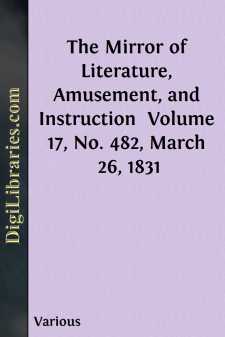Categories
- Antiques & Collectibles 13
- Architecture 36
- Art 48
- Bibles 22
- Biography & Autobiography 813
- Body, Mind & Spirit 142
- Business & Economics 28
- Children's Books 17
- Children's Fiction 14
- Computers 4
- Cooking 94
- Crafts & Hobbies 4
- Drama 346
- Education 46
- Family & Relationships 57
- Fiction 11829
- Games 19
- Gardening 17
- Health & Fitness 34
- History 1377
- House & Home 1
- Humor 147
- Juvenile Fiction 1873
- Juvenile Nonfiction 202
- Language Arts & Disciplines 88
- Law 16
- Literary Collections 686
- Literary Criticism 179
- Mathematics 13
- Medical 41
- Music 40
- Nature 179
- Non-Classifiable 1768
- Performing Arts 7
- Periodicals 1453
- Philosophy 64
- Photography 2
- Poetry 896
- Political Science 203
- Psychology 42
- Reference 154
- Religion 513
- Science 126
- Self-Help 84
- Social Science 81
- Sports & Recreation 34
- Study Aids 3
- Technology & Engineering 59
- Transportation 23
- Travel 463
- True Crime 29
The Mirror of Literature, Amusement, and Instruction Volume 17, No. 482, March 26, 1831
by: Various
Categories:
Description:
Excerpt
BRAY CHURCH.
Who has not heard of the Vicar of Bray, and his turning, turning, and turning again? Here is his church, and a goodly tower withal, which we, in our turn, have endeavoured to turn to the illustration of our pages. There is no sinister motive in the selection; but if we have hit the white, or rather the black, of such variableness, "let the galled jade wince," and pay the Mirror the stale compliment of veluti in speculum.
Bray is a small village about one mile from Maidenhead, and its name would have remained "unsaid, unsung," had it not been for its never-enough-to-be-ridiculed Vicar. Camden supposes Bray to have been occupied by the Bibroci, who submitted to Caesar, and obtained his protection, and with it a secure possession of one of the most beautiful spots in this county; so that submissiveness seems to have been the very air of the place in all times. Philippa, the queen of Edward III., had rents assigned to her from this and the adjoining manor of Cookham. It is now considered as part of the royal domain, being attached to the liberties of Windsor Castle, and retaining some peculiar privileges, among which is an exemption from tolls in the adjacent market-towns. In default of male heirs, lands are not divided here among females of the same degree of kindred, but descend solely to the eldest. The church is "a spacious structure," says the Windsor Guide, and "composed of various materials, and exhibiting a mixture of almost every style of architecture," says the "Beauties of England and Wales;" but we leave the reader to his own conclusion from our Engraving, sketched in the summer of last year. We take for granted the church does not change in appearance every year, if its Vicar once did in creed.
The story of the Vicar of Bray is told with some variations, but the fact is not questioned. In the Beauties of England and Wales we read that his name was Simon Symonds, that he possessed the benefice in the reign of Henry VIII. and the three succeeding monarchs, and that he died in the forty-first year of Elizabeth. "This man was twice a Protestant and twice a Papist; and when reproached for the unsteadiness of his principles, which could thus suffer him to veer with every change of administration, replied, 'that he had always governed himself by what he thought a very laudable principle, which was, never on any terms, if he could avoid it, to part with his vicarage." This creed has been amplified into a song, which we shall quote presently, more for its being a good conceite than for its scarceness.
The author just quoted from the Beauties observes, in a note—"Several late writers, particularly Ireland and Ferrar, who have mentioned the above circumstances, describe them as happening in the reign of Charles the Second, James the Second, &c. This mistake throws the imputation of apostacy on the worthy person who held the vicarage towards the conclusion of the 17th century. It should be remarked, that the story was first published by Fuller, in his Church History; and as the author died in the year 1661, it is evident that it must have been circulated previous to that event."
We have not the Church History at hand, but Fuller, in his Worthies, says, "Bray is a village well known in Barkshire, the vivacious Vicar whereof, living under King Henry the Eighth, King Edward the Sixth, Queen Mary, and Queen Elizabeth, was first a Papist, then a Protestant, then a Papist, then a Protestant again....












